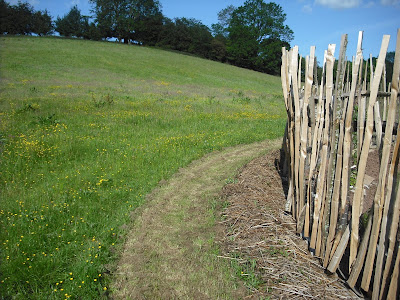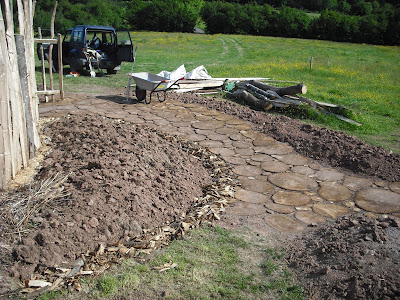Please click HERE if you would like to view a booklet on how to mark out and build a garden like this one.
Applewood recently ran a Training of (Permaculture) Teachers course with Looby Macnamara, Chris Evans and Rosemary Morrow. The link below is for a wonderful short video posted on the Applewood Facebook page.
A wonderful montage of 9 days sharing at Applewood - the Golden Valley Permaculture Centre's Training of Permaculture Trainers 2015
The garden in the first season:
Beautiful cleft ash and chestnut deer fence by Morgan Allen, Herefordshire.
Marking out the garden beds
Cutting the turves and piling them into the beds
Beds edged by Western Red Cedar off-cuts from a mill. The beds were to be raised more, but a change of plan left the posts sticking up. These proved to be useful for reaching into the beds. The keyhole design means there is no need to stand on the soil
all hands on deck to fill the beds
Elf and Weddy
Cardboard sheet mulch, trees and berries planted in the perennial
bed surrounding the 8 raised beds.
Planting began asap as spring was well on the way
all the beds ready and some planted
Continuing with the sheet mulch on the outer perennial bed. The posts on the raised beds also served well for attaching netting and fleece to keep birds and insects off the young plants.
Here it is possible to see the sheet mulch folding over the edge of the pathway. The pathway and the edge were covered with resinous woodchip (from cedar) to be inhospitable to plant growth, natural insect repellant and also more durable due to the resins in the wood. The outer bed was mulched with 'freshwoods' woodchip, mainly Ash, Hazel and Alder chips. These 'freshwoods' do not contain resins which may hinder plant growth. These woods also biodegrade at a faster rate.
A lot of rotted manure and organic compost was added to all the beds to ensure a high nitrogen content. This is important when applying high carbon mulch materials, as they can leach nitrogen from the soil, hindering plant growth.
The garden with fully mulched pathways and outer perennial bed.
The outer bed was also seeded with annual self seeding pollinator seeds. Mainly Phacelia tanacetifolia for the bees, but also some clovers for Nitrogen, and buckwheat for hoverflies. These plant species are self seeding and also green manures.
The site is on a pasture which is heavy populated with the invasive Creeping Buttercup (Ranunculus repens). To prevent this from creeping back into the garden, a 80-100cm wide section of turf was removed around the garden, then sheet mulched with cardboard. A 15-20cm thick mulch of stinging nettles and grass cutings was applied to keep the creeping buttercup out.
.
when necessary the grass was mown around the garden and the clippings placed onto the mulch to keep it topped up. Nettles were also added. By continuing with the mulch, stops weeds from growing and keeps the bottom of the fence free from long grasses and other weeds.
The photo below was the following year before cutting the grass. Some weeds were creeping toward the garden, but they are easily pulled.
The edges of paths and along the bottom of fences are where long grasses and weeds can grow. This would require weeding or strinmming, but sheet mulching and adding mulch material prevents or at least resuces the likelihood of this maintenance requirement at the outset - saving time for other jobs
Here, the pathway was edged with cardboard sheet mulch and woodbark
The garden in its second season
Benches added to the centre circle





















































